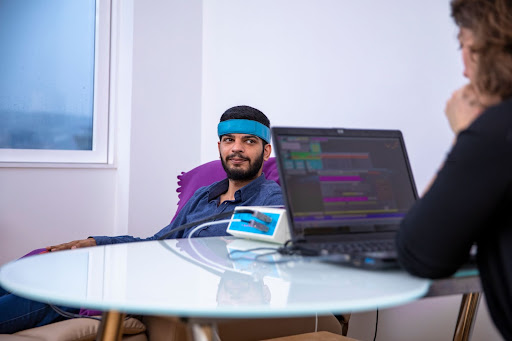Neurofeedback training, often referred to as a ‘gym for your brain’, is a type of therapy which offers us the ability to understand and control our brainwave activity. Around the world, there’s a growing interest in this approach to brain training, as it offers a holistic method of improving emotional wellbeing and enhancing cognitive functions.
Understanding The Basics: What Is Neurofeedback?
Neurofeedback therapy is a non-invasive, drug-free approach that aims to regulate brain activity by providing real-time information about neural processes. It is a type of biofeedback that enables individuals to learn how to self-regulate their brain function.
The roots of neurofeedback can be traced back to the 1960s when researchers discovered that users could alter their brainwave patterns through operant conditioning. Over the years, technological advancements have refined the neurofeedback procedure, making it a highly accessible and effective form of therapy.
Neurofeedback operates on the principle of operant conditioning, creating a feedback loop between the individual’s brain and a monitoring system. Through visual or auditory cues, users receive immediate feedback on their brainwave activity, enabling them to make real-time adjustments, thus training the brain.
The Science Behind Neurofeedback
In neurofeedback training, the primary aim is to target specific brainwave frequencies. For instance, if someone is looking to improve their focus and ability to concentrate, neurofeedback training can be used to encourage the brain to produce more beta waves (associated with active thinking and problem solving). Gradually, the brain will adapt and start naturally producing the desired frequencies, resulting in improved focus.
There are five main types of brainwave frequencies:
- Delta waves – Slow waves, associated with deep sleep and healing
- Theta waves – Occur during deep relaxation or light sleep. These brain waves are linked to creativity and intuition.
- Alpha waves – Appear when we’re in a calm, wakeful state. These brain waves contribute to relaxation and focus.
- Beta waves – Present during active thinking, problem-solving and concentration.
- Gamma waves – The fastest brain waves. These are linked to high-level cognitive functions, including memory and perception.
Applications Of Neurofeedback
Customised neurotherapy techniques can be adapted to suit a range of individual needs. Training programmes are tweaked to address specific aspects of brain function and challenges clients are interested in improving. Here are some of the ways neurofeedback therapy can help you.
Stress Management
Neurofeedback therapy can be used to address brainwave patterns associated with stress, guiding clients to regulate their stress responses and develop a more composed state of mind. This proves beneficial in managing stress-related conditions, such as anxiety.
Improving Sleep Quality
Sleep quality is a common challenge for many. Neurofeedback training specifically targets brainwave patterns related to sleep, including delta waves associated with deep sleep. By doing so, it promotes improved sleep quality and overall restorative rest.
Cognitive Optimisation
Neurofeedback can be used to enhance cognitive functions. Brain training techniques are designed to help clients improve cognitive skills such as memory and attention.
The Process Of Neurofeedback Therapy
The neurofeedback process begins with a comprehensive assessment to understand the individual’s unique brainwave patterns and identify specific areas for improvement.
Through advanced EEG technology, a personalised brain map is created, guiding the development of targeted training protocols.
Clients collaborate with practitioners to establish clear goals, whether addressing mental health concerns or pursuing cognitive enhancement.
Regular sessions involve the individual receiving real-time feedback and learning to modify their brainwave activity through positive reinforcement.
Tailored protocols are designed to address specific goals, with practitioners adjusting parameters based on the individual’s progress.
Regular assessments track improvements, ensuring that the neurofeedback training is effectively achieving the desired outcomes.
Choosing A Neurofeedback Provider
When choosing a neurofeedback therapy provider, there are several factors you need to consider. Firstly, you need to ensure your neurofeedback therapy practitioner has the necessary expertise and training. You can check this by evaluating their qualifications and certificates.
Secondly, you should find out what equipment and technology is used in their practice. A reputable provider should use state-of-the-art equipment and stay abreast of advancements in the field to deliver the most effective and up-to-date services.
Lastly, have a read through client testimonials and reviews to gain an insight into the provider’s effectiveness and client satisfaction. This will serve as a valuable tool in the decision-making process.

